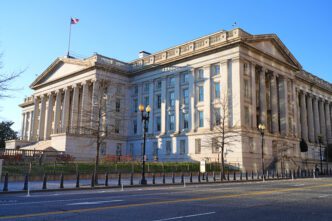Executive Summary
- The United States budget deficit for fiscal year 2025 saw a marginal 2% reduction, primarily due to a significant surge in customs revenues from tariffs imposed by President Donald Trump.
- This deficit contraction occurred despite record-high interest payments on public debt and increased health-related expenditures, while corporate tax receipts declined.
- President Trump’s tariff policies face ongoing legal challenges, with the Supreme Court scheduled to hear arguments, and the deficit figures were released amidst a costly government shutdown.
The Story So Far
- The marginal reduction in the US budget deficit for fiscal year 2025 is primarily attributed to a significant increase in customs revenues from President Donald Trump’s extensive tariffs, which are currently facing a Supreme Court challenge that could lead to substantial refunds. This fiscal development unfolds against a backdrop of record-high interest payments on public debt and increased health spending, which continue to strain the budget.
Why This Matters
- The marginal reduction in the US budget deficit in fiscal year 2025, largely attributed to increased customs revenues from President Trump’s tariffs, presents a fragile fiscal improvement. This positive trend is highly vulnerable, as the Supreme Court’s upcoming ruling on the legality of these tariffs could necessitate significant government refunds, potentially reversing the revenue gains. Additionally, the ongoing government shutdown is introducing substantial economic costs, further complicating the nation’s fiscal outlook and immediate financial stability.
Who Thinks What?
- President Donald Trump publicly highlights the significant increase in customs revenues generated by his tariffs, implicitly viewing them as a successful policy contributing to the budget.
- Treasury Secretary Scott Bessent expresses concern that the Supreme Court might rule against the administration’s tariff policies, potentially compelling the agency to issue significant refunds, and also warns of billions of dollars in economic damage from the government shutdown.
- The Supreme Court is scheduled to hear arguments concerning the legality of President Trump’s tariff policies, indicating that their lawfulness faces ongoing challenges.
The United States budget deficit experienced a marginal reduction in the 2025 fiscal year, which concluded in September, despite a significant increase in customs revenues attributed to tariffs imposed by President Donald Trump. Official data released by the Treasury Department indicated a 2% contraction in the overall deficit, equating to $41 billion, even as interest payments on public debt reached a record high and health spending expanded.
Fiscal Year 2025 Overview
The Treasury Department reported that the total budget deficit for the fiscal year shrank to an estimated 5.9% of GDP, down from 6.3% in the previous fiscal year. This narrowing occurred amid various shifts in government revenues and expenditures. Interest paid on the national debt climbed to $1.2 trillion, marking a new record, while health-related expenditures also saw an increase.
Conversely, customs duties, largely from tariffs, surged from $84 billion to $202 billion year-on-year. Individual income tax collections rose by 6%, reaching $3.5 trillion from $3.3 trillion. However, gross corporate tax receipts declined by 14% to $486 billion, offsetting some of the revenue gains.
Tariff Impact and Legal Challenges
The substantial rise in customs revenues is directly linked to President Trump’s implementation of extensive country-specific tariffs since his return to the presidency. These tariffs also targeted key sectors such as steel, aluminum, and automobiles.
Despite President Trump’s public statements highlighting the tariff revenues, the legality of these measures faces ongoing challenges. The Supreme Court is scheduled to hear arguments concerning the tariffs’ legality next month. Treasury Secretary Scott Bessent previously cautioned in September that the agency might be compelled to issue significant refunds if the high court rules against the administration’s tariff policies.
Government Shutdown and Economic Outlook
The release of the deficit figures coincided with the 16th day of a US government shutdown, stemming from a deadlock in Congress over spending. Secretary Bessent warned that the shutdown was “starting to cut into muscle” and could inflict billions of dollars in economic damage.
A Treasury Department official later clarified that the estimated cost could be as much as $15 billion per week, revising an earlier figure of $15 billion per day provided by Bessent. This estimate is based on a report from the White House Council of Economic Advisers. The government’s deficit calculation aligned closely with estimates published by the nonpartisan Congressional Budget Office approximately a week prior.
Key Takeaways
The marginal narrowing of the US budget deficit in fiscal year 2025 reflects a complex interplay of increased tariff revenues, record public debt interest payments, and fluctuating tax collections. These fiscal developments unfold against a backdrop of ongoing legal scrutiny of President Trump’s tariff policies and the immediate economic pressures of a protracted government shutdown.








